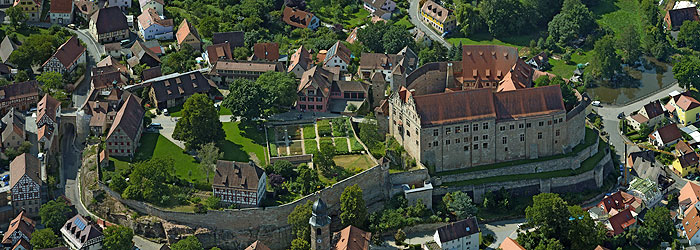Main information:
Cadolzburg Castle
Timeline

1157
First mention in a document of a “Helmericus de Cadolzburg“
1190/91
Friedrich von Zollern in Swabia is appointed burgrave of Nuremberg.
c. 1250
Extensive new buildings erected on the Cadolzburg castle rock (part of the Zollerns’ inheritance from the Abenberg counts)
1256
The first Zollern documents are issued at Cadolzburg.
1273
As a reward for supporting his election, King Rudolf von Habsburg gives Burgrave Friedrich III comprehensive confirmation of his burgravial privileges.
1323
Mining privileges in the Fichtelgebirge (gold, silver, copper and many other materials)
1331
Purchase of Ansbach
1340
The Zollerns inherit the property of the counts of Orlamünde, and Kulmbach and Plassenburg Castle come under their rule.
1349
The imperial court of the burgraviate of Nuremberg is transferred to Cadolzburg
1361
Coin privilege for the burgraves of Nuremberg: they are allowed to mint their own coins (in Langenzenn and Cadolzburg)
1363
Emperor Karl IV awards the Zollerns privileges similar to those of princes.
1387-89
War between the imperial cities (including Nuremberg) and noble princes such as the Zollerns
1411
Friedrich VI becomes administrator of the Mark Brandenburg, partly as a reward for supporting the election of King Sigismund.
1415
Burgrave Friedrich VI receives the Mark Brandenburg and is appointed elector.
1417
Official appointment ceremony at the Council of Constance
1420
The Nuremberg burgraves’ castle is destroyed during the feud with Duke Ludwig von Bayern-Ingolstadt.
1427
Sale of the Nuremberg burgraves’ castle and most of the associated rights for 120,000 guilders
1437
Dispositio Fridericana: Inheritance ruling of Friedrich I, which abolishes primogenitur and formalizes the preservation of internal family unity. Friedrich II receives the Mark Brandenburg and is appointed elector. The oldest son, Johann the Alchemist, shares the ancestral Franconian homeland with Albrecht Achilles.
1440
After the death of Friedrich I, his wife Elisabeth of Bavaria transfers her court to Cadolzburg, where Albrecht Achilles is ruling as margrave in the “land below the hills” around Ansbach and Cadolzburg.
1449/50
First margravial war: Nuremberg against Albrecht Achilles
2nd half of the 15th century
Extension of the Old Palace in Cadolzburg: residential and state rooms are added on the upper floor.
1457
Johann the Alchemist († 1464) abdicates and Albrecht Achilles takes over the government in the “land above the hills”. Johann has the right to reside in Cadolzburg, but lives in Baiersdorf; on his death an alchemist’s laboratory – probably at Cadolzburg – is dismantled.
1470
Albrecht Achilles takes over the Mark Brandenburg from his brother Friedrich II. His governors are trusted councillors and his son Johann (“Cicero”).
1473
Dispositio Achillea: To prevent disputes within the family after his death, Albrecht Achilles appoints his oldest son, Johann Cicero, heir of the imperial territory held by the family as electors, and his half brothers, Friedrich the Elder and Sigmund, heirs of the Franconian principalities.
1486
Albrecht Achilles dies. Division of the Zollern domain into three governmental areas (Brandenburg, Brandenburg-Ansbach, Brandenburg-Kulmbach/Bayreuth); Cadolzburg’s importance as a residence comes to an end.
1515
Margrave Friedrich the Elder is deposed by his sons Kasimir and Georg.
1522
Meeting of the estates in Cadolzburg: because of large debts, the estates force Margrave Kasimir to instate two governors.
1533
Church order under Georg the Pious: the Franconian margraviates finally become Protestant.
2nd half of the 16th century
Extension and modernization of the Cadolzburg New Palace in the Renaissance style. Cadolzburg becomes the official residence.
1603
Margrave Georg Friedrich I dies. The Brandenburg line inherits the two margraviates Brandenburg-Ansbach and Brandenburg-Bayreuth.
From 1702
Records indicate the increasing deterioration of Cadolzburg.
1791
Margrave Karl Alexander von Brandenburg-Ansbach und -Bayreuth sells the margraviates to his Brandenburg relatives.
1806
Brandenburg-Ansbach and -Bayreuth become part of the Kingdom of Bavaria.
1873
Visit by Crown Prince Friedrich Wilhelm of Prussia. He is presented with the Cadolzburg altar, which can be seen today in the Grunewald Hunting Lodge in Berlin.
1894
A museum with a torture chamber is installed in Cadolzburg.
A Catholic chapel is built into the Oriel Hall of the Old Palace.
1898
Emperor Wilhelm II donates a window with a picture of Elisabeth of Bavaria for the castle chapel.
1928
Excavations in the castle courtyard by Heinrich Thiersch
1931
Dissolution of the Cadolzburg district court
1932
Some of the rooms at Cadolzburg (New Palace) are taken over by the State Inner Mission Association of the Evangelical Lutheran church of Bavaria (rural educational centre).
1933-45
The New Palace is used for the Josef Grün School for Hitler Youth leaders.
17.4.1945
The advancing American troops fight a German unit in front of Cadolzburg. During the battle the castle comes under fire and burns until only the outer walls are left.
1979
The state parliament decides to rebuild Cadolzburg.
2007
850th anniversary celebrations at Cadolzburg: the ground floor and first upper floor of the Old Palace have been renovated and are opened to the public.
2017
Renovation of the entire Old Palace completed;
Opening of “A castle and its lords. The Cadolzburg experience”.

Recommendation in the social media
Facebook Twitter Google Plus